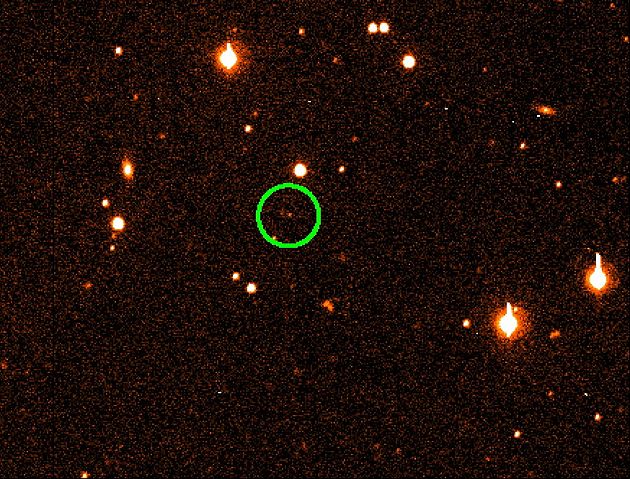 |
This is a file from the Wikimedia Commons. Information from its description page there is shown below.
Commons is a freely licensed media file repository. You can help.
|
Summary
| Description |
Sedna was discovered from an image dated 2003-11-14 at coordinates 03 15 10.09 +05 38 16.5. The 3 overexposed stars are apparent magnitude 13. The "bright star" near Sedna is apmag 14.9 and about the same magnitude as Pluto. (Wikisky image of this region)
The picture shows an area of the sky equal to the area covered by a pinhead held at arm's length. Sedna is too faint to be seen by all but the most powerful amateur telescopes. |
| Date |
18 April 2005 (original upload date) |
| Source |
Caltech animated gif of the Sedna discovery images (True source image using green circle from Caltech website)
http://photojournal.jpl.nasa.gov/catalog/PIA05568 (Samuel Oschin Telescope 2003-11-14. Rotated and flipped; using yellow arrows) |
| Author |
This is the discovery image of Sedna taken with the Palomar Observatory's 48-inch Schmidt Telescope (now called the Samuel Oschin Telescope). JPL public web sites (public sites ending with a jpl.nasa.gov address) |
License
| Public domainPublic domainfalsefalse |
 |
This file is in the public domain because it was solely created by NASA. NASA copyright policy states that "NASA material is not protected by copyright unless noted". (See Template:PD-USGov, NASA copyright policy page or JPL Image Use Policy.) |
|
|
|
Warnings:
- Use of NASA logos, insignia and emblems are restricted per US law 14 CFR 1221.
- The NASA website hosts a large number of images from the Soviet/ Russian space agency, and other non-American space agencies. These are not necessarily in the public domain.
- Materials based on Hubble Space Telescope data may be copyrighted if they are not explicitly produced by the STScI. See also {{ PD-Hubble}} and {{ Cc-Hubble}}.
- The SOHO (ESA & NASA) joint project implies that all materials created by its probe are copyrighted and require permission for commercial non-educational use.
- Images featured on the Astronomy Picture of the Day (APOD) web site may be copyrighted.
|
File usage
The following pages on Schools Wikipedia link to this image (list may be incomplete):
Through Schools Wikipedia, SOS Children has brought learning to children around the world. SOS Childrens Villages helps those who have nothing and no one, giving them back the famly they have lost and bringing them the very best opportunities for a happy, healthy future. Try to find out how you can help children in other countries on our web site.





